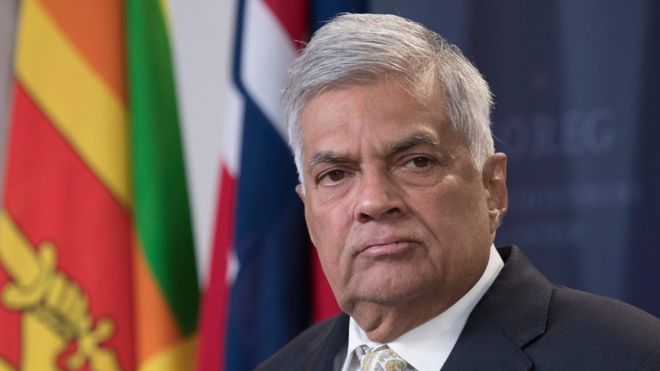Colombo: Prime Minister Ranil Wickremesinghe Saturday offered to resign and form an all-party government, hours after thousands of protesters stormed the official residence of President Gotabaya Rajapaksa who appears to have gone underground in the face of massive public anger over an unprecedented economic crisis that has brought Sri Lanka to its knees.
In remarkable scenes, hinting at a society in a meltdown, anti-government protesters were seen occupying a bedroom, sitting on a four poster bed, helping themselves to food in the kitchen and splashing in a swimming pool in Gotabaya’s residence.
His whereabouts were unknown and it is believed the the 73-year-old leader left the house before the massive mob arrived.
With no other political solution in sight, Wickremasinghe, who was appointed by Gotabaya in May to fix the island nation’s bankrupt economy, offered to step down. Wickremesinghe was appointed by the president after his elder brother Mahinda Rajapaksa was forced to resign in May, amidst massive anti-government protests.
The Prime Minister’s Media Division said that Wickremesinghe will resign after an all-party government is established and a majority is secured in Parliament.
Wickremesinghe told Opposition party leaders that he was taking the decision to step down as the island-wide fuel distribution is due to recommence this week, the World Food Programme Director is due to visit the country this week and the debt sustainability report for the International Monetary Fund is due to be finalised shortly.
Wickremesinghe said in a voice statement that he will resign when all parties have agreed on a new government.
Protesters have now also entered the official residence of Wickremesinghe. Videos show protesters taking selfies on beds and sitting on furniture, while hundreds have been chanting “we say go now” and waving Sri Lankan flags in the main foyer of the house.
At least 45 people, including seven security personnel, were injured in clashes between security forces and the protesters – some of them holding Sri Lankan flags and helmets – who had gathered in large numbers in the Fort area, demanding President Rajapaksa’s resignation.
Amidst the turmoil, Wickremesinghe summoned an emergency meeting of all political parties and also requested the Speaker to summon Parliament.
During a meeting summoned by Speaker Mahinda Yapa Abeywardena, political party leaders pressed for an all party government while calling for President Gotabaya’s resignation.
The main Muslim party leader Raul Hakeem told reporters that party leaders wanted both President Rajapaksa and Prime Minister Wickremesinghe to resign and Speaker Abeywardena to become acting president as per the Constitution.
The Constitution stipulates under article 40C that the Prime Minister must act as the President until Parliament could appoint an acting president within one month of president vacating office.
However, the Opposition is opposed to Wickremesinghe becoming interim president as he was not elected by the people. He entered Parliament as an appointed member having failed to win a seat in the parliamentary election held in August 2020.
Sri Lanka, a country of 22 million, is under the grip of an unprecedented economic turmoil, the worst in seven decades, crippled by an acute shortage of foreign exchange that has left it struggling to pay for essential imports of fuel, and other essentials.
Protesters blame President Rajapaksa’s government for the country’s economic malaise, the worst since independence in 1948.
Last week, Prime Minister Wickremesinghe announced in Parliament that Sri Lanka would present a debt restructuring programme to the IMF by August to secure a bailout package while underlining that the negotiations with the global lender were more complex and difficult than in the past because the country was “bankrupt”.
The country, with an acute foreign currency crisis that resulted in foreign debt default, had announced in April that it is suspending nearly USD 7 billion foreign debt repayment due for this year out of about USD 25 billion due through 2026.
Sri Lanka’s total foreign debt stands at USD 51 billion.
Saturday’s protest is the biggest protest yet to sweep Sri Lanka. The protesters also clashed with the railway authorities in provincial towns of Galle, Kandy, and Matara as the demonstrators forced authorities to operate trains to Colombo.
Large contingents of police, special task force, and the Army had been deployed around the area.
The organisers of the movement ‘Whole country to Colombo’ said people were walking from the suburbs to join the protesters at Colombo Fort.
Protesters said they will not relent until Rajapaksa quits the presidency.
Meanwhile, US Ambassador to Sri Lanka Julie Chung has urged the country’s military and police to allow peaceful protests.
“Violence is not an answer… Chaos & force will not fix the economy or bring the political stability that Sri Lankans need right now,” she tweeted.
PTI
